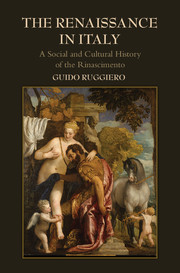Book contents
- Frontmatter
- Dedication
- Contents
- List of Illustrations
- Acknowledgments
- Maps
- Introduction: The End of the World and Its Rebirth (Rinascita) as the Rinascimento
- 1 Legitimacy: A Crisis and a Promise (c. 1250–c. 1340)
- 2 Civiltà: Living and Thinking the City (c. 1300–c. 1375)
- 3 Plague: Death, Disaster, and the Rinascita of Civiltà (c. 1325–c. 1425)
- 4 Violence: Social Conflict and the Italian Hundred Years’ War (c. 1350–1454)
- 5 Imagination: The Shared Primary Culture of the Early Rinascimento (c. 1350–c. 1475)
- 6 Courts: Princes, Aristocrats, and Quiet Glory (c. 1425–c. 1500)
- 7 Self: The Individual as a Work of Art (c. 1425–c. 1525)
- 8 Discovery: Finding the Old in the New (c. 1450–c. 1560)
- 9 Re-Dreams: Virtù, Saving the Rinascimento, and the Satyr in the Garden (c. 1500–c. 1560)
- 10 Reform: Spiritual Enthusiasms, Discipline, and a Church Militant (c. 1500–c. 1575)
- 11 Retreat: The Great Social Divide and the End of the Rinascimento (c. 1525–c. 1575)
- Epilogue: The Diaspora of the Rinascimento
- Bibliography: A Short List of Works Used
- Index
- References
Bibliography: A Short List of Works Used
Published online by Cambridge University Press: 05 December 2014
- Frontmatter
- Dedication
- Contents
- List of Illustrations
- Acknowledgments
- Maps
- Introduction: The End of the World and Its Rebirth (Rinascita) as the Rinascimento
- 1 Legitimacy: A Crisis and a Promise (c. 1250–c. 1340)
- 2 Civiltà: Living and Thinking the City (c. 1300–c. 1375)
- 3 Plague: Death, Disaster, and the Rinascita of Civiltà (c. 1325–c. 1425)
- 4 Violence: Social Conflict and the Italian Hundred Years’ War (c. 1350–1454)
- 5 Imagination: The Shared Primary Culture of the Early Rinascimento (c. 1350–c. 1475)
- 6 Courts: Princes, Aristocrats, and Quiet Glory (c. 1425–c. 1500)
- 7 Self: The Individual as a Work of Art (c. 1425–c. 1525)
- 8 Discovery: Finding the Old in the New (c. 1450–c. 1560)
- 9 Re-Dreams: Virtù, Saving the Rinascimento, and the Satyr in the Garden (c. 1500–c. 1560)
- 10 Reform: Spiritual Enthusiasms, Discipline, and a Church Militant (c. 1500–c. 1575)
- 11 Retreat: The Great Social Divide and the End of the Rinascimento (c. 1525–c. 1575)
- Epilogue: The Diaspora of the Rinascimento
- Bibliography: A Short List of Works Used
- Index
- References
- Type
- Chapter
- Information
- The Renaissance in ItalyA Social and Cultural History of the Rinascimento, pp. 591 - 600Publisher: Cambridge University PressPrint publication year: 2014



